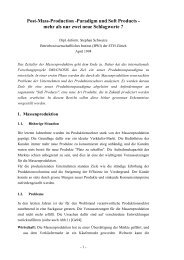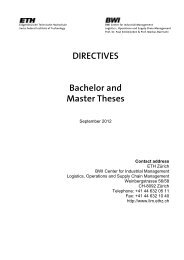The China Venture
The China Venture
The China Venture
You also want an ePaper? Increase the reach of your titles
YUMPU automatically turns print PDFs into web optimized ePapers that Google loves.
and the other one in <strong>China</strong>. <strong>The</strong> company organised its Asian activities through sales offices<br />
in <strong>China</strong>, Hong Kong, Indonesia, Japan, Singapore, Taiwan and Thailand.<br />
LGC started the process of building up its joint venture in <strong>China</strong> already in the mid 1980s. By<br />
doing so it could draw on the 25 years long experience of its Hong Kong office. 50 per cent of<br />
the joint venture was owned by LGC, the rest by two Chinese partners, one of them a<br />
government agency.<br />
<strong>The</strong> company encountered little problems in starting up production and it also managed to<br />
achieve its goal to stimulate the development of a local fashion industry that would use some<br />
of LGC's core products as raw materials. <strong>The</strong>re were no quality problems with the products as<br />
export goals could be easily met.<br />
However, internal sales did not develop according to plan. <strong>The</strong> partner company did not meet<br />
LGC's expectations as far as distribution and logistics was concerned. Also, the partner did<br />
not offer the expected network of contacts to relevant business partners. Managerial problems<br />
were caused by a lack of co-operation between the foreign and local partners. Managers<br />
appointed by the Chinese side tried to short cut decision making by LGC's general manager.<br />
This resulted in bad business decisions, among which was the hiring of inappropriate staff.<br />
Internal problems of the company were further worsened by a market which initially proved<br />
smaller than forecast, by problems in exporting to other regions, and by a quickly emerging<br />
competitive environment. Competitors soon managed to offer similar products, albeit at lower<br />
quality, at much cheaper prices.<br />
<strong>The</strong>se trends did not escape the attention of the managers at LGC's headquarters. For a long<br />
time they tried to mend the problems within the existing organisational structure but had<br />
finally realised that a complete re-evaluation and repositioning of the company's activities in<br />
<strong>China</strong> was necessary.<br />
For this purpose, the management formed a team of specialist at the European headquarters.<br />
This group could draw on information from within <strong>China</strong>, within the region, most notably<br />
from its regional office in Hong Kong, as well as from outside sources. LGC attributed<br />
enough attention to this repositioning process to invite professional, as well as semi-<br />
professional consultants to join their efforts to reposition the company's strategies. 143<br />
143 One of these groups of outside advisors was headed by the author together with a fellow<br />
researcher, Reza Rahimi. <strong>The</strong> team also included nine graduate students of the University of St.<br />
Gallen, Switzerland.<br />
143






